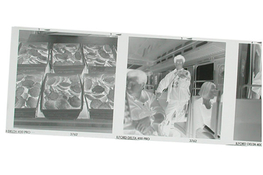logan2z
Subscriber
I use 500ml for my 1500 tanks and the 3010 Expert Drum and have never had your problem.
Inversion or rotation?
I use 500ml for my 1500 tanks and the 3010 Expert Drum and have never had your problem.
Inversion or rotation?
Rotation using the CPP2 processor.

Ok, I'm going to give rotation a shot and see if that helps eliminate my air bell problem - hopefully without introducing any new problems
No real reason. I only recently started home developing my film and started with inversion agitation, so I've just been working through some rolls that way. I don't have a full-blown Jobo processor but I picked up the Jobo roller a few weeks back with a plan to try manual rotary processing. This seems like a good time to give that a shot.Why would one not use the processor??
I presume that the "theory" is that constant rotation in a horizontal plane either prevents airbells forming or prevents air bells sticking as the rotation is of sufficient speed to either prevent airbells sticking or is sufficient to dislodge the airbells immediately from the film surface?
Does anyone know which of the above, if any, is correct and why the rotational movement prevents airbells or prevents sticking better than a good rap on the tank's bottom at the end of the inversion cycle?
We have had over the years several threads on airbells but I can't recall anyone saying that the one sure cure is to switch to rotary processing
pentaxuser
I presume that the "theory" is that constant rotation in a horizontal plane either prevents airbells forming or prevents air bells sticking as the rotation is of sufficient speed to either prevent airbells sticking or is sufficient to dislodge the airbells immediately from the film surface?
Does anyone know which of the above, if any, is correct and why the rotational movement prevents airbells or prevents sticking better than a good rap on the tank's bottom at the end of the inversion cycle?
We have had over the years several threads on airbells but I can't recall anyone saying that the one sure cure is to switch to rotary processing
pentaxuser


I just did a rigorous, scientific experiment with... an empty, clear orange juice bottle and some water
I almost filled the bottle with water but left a bit of room at the top. I gently inverted the bottle 3 or 4 times and set it upright. Bubbles could be seen moving quickly towards the top of the bottle.
I let the bubbles dissipate and then turned the bottle horizontally and performed several smooth rotations. I then turned the bottle upright and - zero bubbles!
I'm convinced
Of course!
With or without Vodka?



Maybe I need to make a darkroom print to really prove that the bands are on the negatives
OK, so I tried the Jobo roller on my latest roll of 120 Tri-X and scanned the roll.
The good news: I don't see any sign of air bells on my negatives. Development also appears to be very even - large swaths of sky look great on nearly every negative.
Now, the bad news. The last two negatives on the roll appear to show some vertical banding in exactly the same location on both negatives. Looks like bands of negative density to me. No sign of it anywhere else on the roll. These would be the innermost frames on the reel since I'm loading the reel starting from the tape side/end of the roll.
I rolled the tank in a bidirectional fashion, switching directions every two rotations. I kept the rate of rotation as constant as possible. I did not presoak the film.
I've included scans of the two frames. I tried scanning the negatives emulsion side up, emulsion side down and flipped 180 degrees to try and eliminate a scanner fault but the bands remained.
It's really hard to visually verify whether these bands are actually on the negatives - at first glance, even with a loupe, the negatives look fine. But I believe I can see the bands if I look really, really closely with the film on a lightpad.
I'm not sure what could have caused this with 120 film (no sprocket holes) and rotary processing. The bands look to be perfectly straight and in the same location on both frames - and only those frames.
Here's the scans, darkened to emphasize banding:


The frame right before these two looks fine, as do all others on the roll:

Maybe I need to make a darkroom print to really prove that the bands are on the negatives, but I believe they are.
I'm not going to lie, I'm getting a bit frustrated...


a bottle of plain water
It's there, clearly visible to me. Sometimes it helps to scroll your screen/window perpendicular to the direction of the bands; makes them easier to spot. Or copy the image in Photoshop and boost contrast. Neither is necessary for me to see those bands, though. They're pretty obvious.I cannot see the banding on any of the photos.


I suppose Logan might be just one of those unlucky individuals for whom whatever can go wrong does go wrong


 "
" | Photrio.com contains affiliate links to products. We may receive a commission for purchases made through these links. To read our full affiliate disclosure statement please click Here. |
PHOTRIO PARTNERS EQUALLY FUNDING OUR COMMUNITY:  |